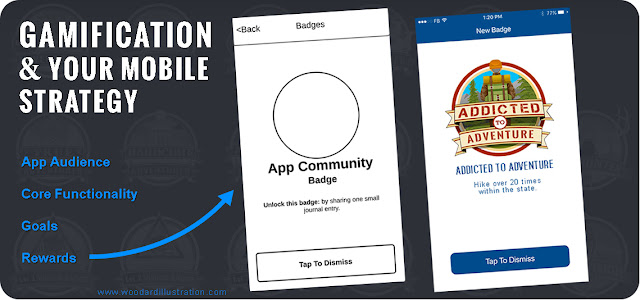Introducing Gamification Into Your Mobile Strategy
You may have heard the term Gamification being thrown around a great deal in recent years. I would consider the Gamification of an application a key component of the overall User Experience in that good gaming mechanics lead to a pleasant experience and continued application use. If your application features repetitive functionality, Gamification may assist in keeping the user engaged and coming back for more. It may also contribute to a more competitive/active social environment within your application’s community. Any company wanting to create a public facing application with hopes of engaging it's audience should consider moving in this direction.
App Audience – Every
application has a target audience and identifying and catering to this audience
is key to a successful User Experience and Gamification. Your audience may be
diverse or it may be a specific target demographic. It is important to evaluate
your target audience’s expectations and preferences and reflect those within
your design.
Core Functionality – Whether
it’s the ability to search for locations or share activities, your application
should have core functionality that is attracting your user base. Adding a game
mechanic should not hinder the core functionality in any way, and this cannot
be emphasized enough. Once you’ve identified your apps specific features, you
can define goals that will then
drive a reward system.
Goals & Rewards –
What are you wanting to encourage within your application? If you are
wanting a function to be done multiple times, you may want to set a reward for
every few times that action is completed. If you want to encourage app users to
be social, you may offer rewards when they share something. The difficulty with
setting goals and rewards is identifying the tiers at which the rewards will be
given. Does the user receive a reward for doing that function once or do they
have to perform it multiple times?
The example below
shows how the application may have three specific features (desired actions)
that we’re wanting to encourage the users to perform. The feature that has the
highest repeatability also has the largest number of badges and the feature
that has the lowest estimated repeatability has the smaller number of badges.
Go through the exercise of listing out features (ex: login,
check-in at location, report activity, share photo…) and predict the repeatability
of those features to determine the number of rewards needed. This exercise may
also help determine what reward type(s) to use.
A high value reward may be more appealing than a larger
number of badges, so Action#3 may reward the user with a discount/prize as to
encourage more users to perform that feature.
Reward Types – However you implement
the rewards, they should be appealing to your audience and not hinder the use of
the core functionality. Multiple combinations of the following reward
strategies allow you to cater your application to your audience.
- Badging- A very common reward system for mobile apps where users are awarded custom badges (images) that represent the goals they achieved (ex: I check-in at a gas station and am awarded a “Lvl 1 Visitor Badge”, I check into the same gas station a few days later and am awarded a “Lvl 2 Visitor Badge”)
- Leveling- Another common reward system where users achieve a status based off of progress towards a goal. A user would start at a beginner level, and through accruing points, they would unlock the next level. (ex. A first time user is “Beginner”. They can level up by performing set functionality and accruing points.)
- New Features/Privileges- Unlock an app feature or privilege based off of reaching a goal. (ex. A user may be able to share more content after they have shared 20 basic posts)
- Prizes & Discounts- This reward would probably be hidden from the user. They could be awarded a prize or discount based off of unlocking a badge, new level, or at random. (ex. The app company can award discounts or prizes to encourage users to try and achieve particular badges, levels, or overall activity.)

